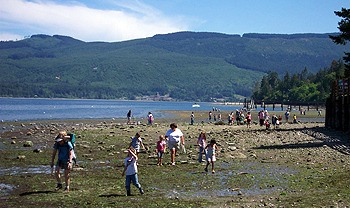During the hottest part of the unsettling heat and dryness, my husband and I found ourselves paying a lot more attention to weather forecasts. One particular forecast was being broadcast while we were in a Seattle area hotel having a so called continental breakfast of chunks of scrambled eggs and 1,000-calorie-each muffins.
The local Seattle weatherman was excitedly talking about heat and more heat and happened to show a “beach in Sequim.” He said, “I always wondered why the people of Sequim are not out on the beach. Every time I show this view, the beach is empty.”
“Good question,” I thought — although one explanation could be the rocky uneven beach that is perilous for some of our older residents. I e-mailed the weatherman at the station and asked where the camera was located. Despite being labeled as someone who really wanted to hear from viewers, I didn’t get a response.
My research, albeit a little spotty, led me to conclude that most of the beach front of Sequim is privately owned; therefore, most people aren’t allowed on the beaches. One 2006 report source points out that 61 percent of Washington tidelands were transferred to private ownership from 1890-1979.
What’s left for the public in Sequim is pretty neat for the campers, boaters, shellfish hunters, hearty walkers and fish — the Dungeness Spit (if that counts as Sequim); Sequim Bay State Park, a well-equipped camping site; Port Williams Beach, small but nice, and the land at the end of Three Crabs Road that was purchased by the state and is being restored for salmon and other wildlife.
Most of the longer stretches of Sequim’s flat beaches are on private property. The owners, quite understandably, don’t want people cooking hot dogs over a fire and kids building castles on their beaches or tidelands. But, they don’t seem to want anyone to linger long enough to even think about touching their property.
I came out of a childhood spent in a developing neighborhood in what used to be rural North Seattle. We played games like hide and seek and wild horses in vacant lots without a thought of trespassing. I collected “their” caterpillars and grasshoppers and built cities in cardboard boxes without thinking those creatures were “theirs.”
Decades later, I experienced something so different when we moved to Sequim — fences and no-trespassing signs. My child head thought it sad; my adult head thought it necessary to avoid lawsuits. My adult heart felt it was yet one more aspect of our growing separation from each other.
Stay off my beach! And my road!
One of my favorite walks is the one that takes me down and around Jamestown Road from Sequim-Dungeness Way to the water. I walk with nature, admire the snags and enjoy the rural feel of the neighborhood.
Over years now of walking the road, I noticed an increase in signage advising me to keep away. The signs seem to have gotten either more belligerent or more desperate. I don’t know the motivation of owners but I do know I feel unwelcome in the vicinity and possibly somewhat hunted.
The first encounter on my walk is a road marked residents and guests only, no exit sign on one side and “The Beach” private community sign on the other side. Farther on were roads with signs that shouted keep out, no outlet, resident vehicles only or residents only. No, they did not want me to walk on their road.
Two roads had additional signs that read, “Smile, you’re on camera, video surveillance” or “Smile, you are being videotaped,” complete with yellow happy faces.
Since the face was below the blunt messages, I don’t think it was meant to soften the message but rather a modern day version of “trespassers will be shot.”
I wasn’t even at the water yet. Once on the public road that intersected houses and the beach, I was barred from the beach by more signs and ropes by owners, private beach clubs and the Jamestown S’Klallam Tribe. At the end where the road turns south was a small occupied two-car parking space next to at least two signs that read, “no parking on the gravel.” That and an owner’s “no parking” sign seriously limited any possibility of staying if one drove to the entrance to Graysmarsh Public Access Area.
I don’t know what’s happened to create the unwelcome atmosphere of this beach neighborhood. In all my walk years, I’ve haven’t seen crowds of people with their noses pressed against the no outlet signs clamoring to get in.
I promise. I won’t walk on your road or beach. I know when I’m not wanted.
Watching neighborhood waves
Most of us live in neighborhoods that don’t seem to mind walkers. I haven’t noticed “no trespassing” signs on vacant lots but see a few private signs on driveways in my neighborhood.
Several years after we arrived, we put a private sign on our steep driveway because some drivers thought it a way to reach the road above only to land in front of our garage. We waved and most embarrassed drivers smiled and drove away.
We see people park their cars and walk their dogs in the area. Being a cat person, I’m not sure what the attraction is except that we live in a dog-friendly neighborhood. We also live in a people-friendly area. I have yet to walk and not have a passing walker greet and/or wave.
I find myself smiling a lot at trees, clouds and mountains. No doubt I’ve appeared on Jamestown surveillance tapes because I have stopped several times in an effort to understand. I couldn’t quite bring myself to smile.
Bertha D. Cooper is retired from a 40-plus year career as a health care administrator focusing on the delivery system as a whole. She still does occasional consulting. She is a featured columnist at the Sequim Gazette. Reach her at columnists@sequimgazette.com.



